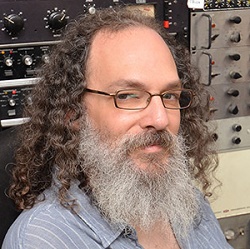
UA: Let’s talk about the Universal Audio products you use. You’re mixing on a console, but do you use a lot of plug-ins, as well?
AS: It’s interesting how it’s evolved. I use tons of outboard gear, but I also use quite a few plug-ins. It sort of breaks itself into two parts, where half of the plug-ins I use are for repair purposes, like surgical EQing and things like that. The other half are for very specific sonic things that they do, that you just can’t get elsewhere.
One of the plug-ins I’ve been using a lot lately from UAD is the EMT 250 Classic Electronic Reverb Plug-In. I use that reverb, because it’s such a specific sound, and that plug-in really does capture it. And so if you want a 250, then there you go.
“UAD stuff is very much based on hardware that I’m familiar with. I’ve got a huge palette of stuff that’s always available.”
UA: How about the EMT 140 Classic Plate Reverberator Plug-In, have you used that, as well?
AS: I have. I’ve used that quite a bit lately, too. And not so much because it sounds exactly like a plate, but just because it definitely has its own character. And I don’t use a lot of reverb, but when I use it, it’s either a spring, or a reverb like the 140—even though it’s not based on an impulse response, which you would say would be the most natural reverb. For the style of records that I love, which is the older rock stuff, the reverb that you hear most often is a plate or a 250.
UA: Since you came out of the tape era, do you like using the Studer A800 Multichannel Tape Recorder Plug-In and the Ampex ATR-102 Mastering Tape Recorder Plug-In?
AS: Well, I’ve used the Studer a little bit, but the Ampex, yes, to the point where I overused it. [Laughs] I actually had to ween myself off of it. Because, you can do so much with that plug-in, and I was doing way too much. And it was so much fun. But unfortunately, I was doing that instead of mixing.
UA: Describe how it enhanced the tracks.
AS: It allowed me to rebalance the frequency spectrum on a track. I could totally change the top end to where it really sounded like I went through, track by track, and re-EQed things, and added compressors, and did all sorts of stuff—but all I did was slap a plug-in on it.
UA: Does the source sound more like tape after you’ve put that plug-in on it?
AS: It’s hard to say, because for me, at the moment, I have a real love-hate relationship with tape machines. Tape itself is so inconsistent, and tape machines are so badly maintained, that I’m almost a little wary of tape. I love working on tape, and I love tracking a band on 2-inch tape, because you make decisions, and you move on. There’s something great about that, aside from the whole analog/digital debate—and everybody’s on both sides of that all of the time. But due to the realities of physically getting the tape machine to work, it’s gotten to where sometimes it doesn’t sound better.
Not only as Scheps has engineered countless hit songs, including tracks from Red Hot Chili Peppers, Adele, and Metallica, he has also produced records such as Bruiser, by The Duke Spirit.
UA: How do you usually set the ATR plug-in?
AS: I tend to use the ATR in much more extreme settings than I would a tape machine. Like with the 1-inch head, but at 15ips. And then I’ll start to get the crosstalk up a little bit, and then realign the machine. When I actually use a tape machine, I tend to align it properly, and use it properly, and keep all the levels within range, because once you go out of range, every tape machine reacts differently. Some are forgiving, and some are absolutely not. With a plug-in you can do crazy stuff.
UA: You can certainly change the alignment a lot faster on a plug-in than on a real tape machine.
AS: I’ve ended up saving a bunch of crazy alignments, and I’ll cycle through them. I’ll probably go back to trying it on individual elements, more as a tonal tool. And that’s one of the things I like about plug-ins in general now. There’s a real attention being paid to their sonic character.
UA: What other UAD-2 plug-ins do you use?
AS: The new 1176 Limiter Collection, because I own five original 1176s, but that’s not enough. They are my favorite compressors.
UA: How are the new UAD 1176 plug-ins different from the previous one?
AS: I’d say they’re just more accurate. And they’re more accurate in the extreme settings, which is where I use 1176s quite often — with attack and release all the way down, or with multiple ratio buttons in.
And 1176s do very particular things in those situations, which nothing else does. And it can be quite subtle, but it’s something that you grow to expect from the hardware. And these plug-ins just do all that stuff, they really do react quite a bit like the hardware. And they have different flavors of 1176s. They’ve got the Bluestripe, the AE, and the Blackface LN.
“The reason I got the [UAD-2] Satellite, is that … I’ve gone out with [The Chili Peppers] to do their initial promo tours, where they’re playing lots of TV shows and concerts that have to be broadcast the next day. … I ended up mixing these promo appearances almost like I’m the front of house guy.”

